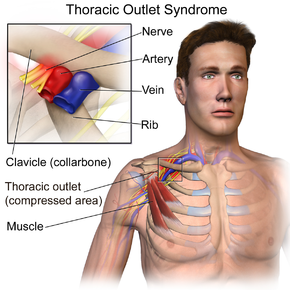|
BOOK NOW |
ASK ABOUT YOUR PAIN |
Home > Physiotherapy / Hand Therapy > Blog > Vague arm pain? Suffering From Pins and Needles or Heaviness?
Vague arm pain?
Suffering From Pins and Needles or Heaviness?

There are many causes of pain of the whole arm in adults.
And this type of vague nerve-type pain can be
- anxiety provoking
- worrisome and
- significantly affect function of the arm
In most conditions a very specific part of the arm is affected – usually depending on where the problem is and what specific structure is affected.
With some conditions however, the pain and symptoms are more
general and influence the whole arm, which cause vague arm pain.
Thoracic Outlet Syndrome
Thoracic outlet syndrome condition can involve
- the nerves of the Brachial Plexus or
- the blood vessel of the arm
Typically, symptoms of Thoracic Outlet Syndrome include a
- general ache in the whole arm
- heaviness or a feeling that the muscles of the arm become easily and quickly fatigued.
The symptoms of Thoracic Outlet Syndrome are usually made worse by having the hands above the head or in elevated positions for a prolonged period of time. These symptoms might start consistently after a certain amount of this activity but then ease quite quickly once the arms are lowered again.
Normally when the patient rest, the symptoms subside.
Because either the nerves or the blood vessels can be affected in thoracic outlet syndrome, there are some differences in the symptoms that might occur:

1) Neurogenic (nerve) thoracic outlet symptoms
For this version of Thoracic Outlet Syndrome, the symptoms may include pins and needles or numbness in the arm with movement, load and activity. It can also lead to pain in the arm (sometimes it's a burning sensation) and other times this pain can follow a pattern in the arm that follows specific nerves if they are affected.
If the conditions have been going on for a while, and the nerves have been significantly influenced, the muscles that those nerves supply will also be affected eg weakness and decreased mobility.
Often it is the lower nerves from the neck that are affected and these usually present as symptoms in the little finger and ring finger and under side of the forearm but this is not always the case.
2) Vasculogenic (blood vessel) thoracic outlet symptoms
If the blood vessels have been affected then the pain is often described as
- aching
- heavy and
- the arm gets tired or fatigued very quickly.
If the blood vessels are affected it can mean that the blood supply for the rest of the arm is not 100% and so changes can occur in the quality of the healing rate, circulation, color, strength etc of the affected arm. There may be sensory loss or numbness as well.
A large proportion of the assessment for these conditions is based on a clear and accurate discussion of the clinical symptoms between the senior physiotherapist, senior hand therapist, the doctor and the patient. Identifying this clear ‘on/off type’ pain with above head activities and the description of the pain would give a good idea of the diagnosis.
In addition to this there are some clinical tests used to add strength to a diagnosis. Some of these include the
- Adsons Test
- Allens Test and
- Roo’s Test procedures
These tests all look to add extra stress to the vascular tissues that are in question so that symptoms may start or blood flow (assessed by checking the pulse at the wrist) can be monitored.
Other tests used to determine if nerves are being effected include neurodynamic tests which stress the nerves and look for reproduction of symptoms.
Once a clear diagnosis has been reached, then treatment can be aimed at the structures that may be causing irritation of the blood vessels or nerves. Clear diagnosis is the primary aim as it leads to clear explanation to the patient and understanding of their condition and what might aggravate it.
vague arm pain physiotherapy treatment
Physiotherapy treatment aimed towards reducing stress on the irritated structures can then be given. For example, this might include
- Stretching or
reducing tension in muscles that might be compressing tissues or
- changing the way these are performed can also enable better movement and overall glide of tissues
- Strengthening and stretching exercises can help strengthen and lengthen the muscles surrounding the shoulder so
that they are better able to support the collarbone.
- Postural exercises
can help you stand and sit straighter, which lessens the pressure on the
nerves and blood vessels by increasing/improving the space around the shoulder and rib cage